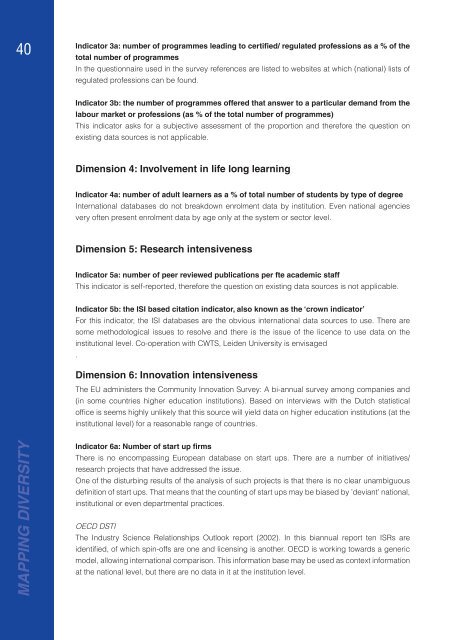Mapping Diversity: Developing a European Classification of ... - U-Map
Mapping Diversity: Developing a European Classification of ... - U-Map
Mapping Diversity: Developing a European Classification of ... - U-Map
Create successful ePaper yourself
Turn your PDF publications into a flip-book with our unique Google optimized e-Paper software.
Indicator 3a: number <strong>of</strong> programmes leading to certified/ regulated pr<strong>of</strong>essions as a % <strong>of</strong> the<br />
40<br />
total number <strong>of</strong> programmes<br />
In the questionnaire used in the survey references are listed to websites at which (national) lists <strong>of</strong><br />
regulated pr<strong>of</strong>essions can be found.<br />
Indicator 3b: the number <strong>of</strong> programmes <strong>of</strong>fered that answer to a particular demand from the<br />
labour market or pr<strong>of</strong>essions (as % <strong>of</strong> the total number <strong>of</strong> programmes)<br />
This indicator asks for a subjective assessment <strong>of</strong> the proportion and therefore the question on<br />
existing data sources is not applicable.<br />
Dimension 4: Involvement in life long learning<br />
Indicator 4a: number <strong>of</strong> adult learners as a % <strong>of</strong> total number <strong>of</strong> students by type <strong>of</strong> degree<br />
International databases do not breakdown enrolment data by institution. Even national agencies<br />
very <strong>of</strong>ten present enrolment data by age only at the system or sector level.<br />
Dimension 5: Research intensiveness<br />
Indicator 5a: number <strong>of</strong> peer reviewed publications per fte academic staff<br />
This indicator is self-reported, therefore the question on existing data sources is not applicable.<br />
Indicator 5b: the ISI based citation indicator, also known as the ‘crown indicator’<br />
For this indicator, the ISI databases are the obvious international data sources to use. There are<br />
some methodological issues to resolve and there is the issue <strong>of</strong> the licence to use data on the<br />
institutional level. Co-operation with CWTS, Leiden University is envisaged<br />
.<br />
Dimension 6: Innovation intensiveness<br />
The EU administers the Community Innovation Survey: A bi-annual survey among companies and<br />
(in some countries higher education institutions). Based on interviews with the Dutch statistical<br />
<strong>of</strong>fi ce is seems highly unlikely that this source will yield data on higher education institutions (at the<br />
institutional level) for a reasonable range <strong>of</strong> countries.<br />
MAPPING DIVERSITY<br />
Indicator 6a: Number <strong>of</strong> start up firms<br />
There is no encompassing <strong>European</strong> database on start ups. There are a number <strong>of</strong> initiatives/<br />
research projects that have addressed the issue.<br />
One <strong>of</strong> the disturbing results <strong>of</strong> the analysis <strong>of</strong> such projects is that there is no clear unambiguous<br />
defi nition <strong>of</strong> start ups. That means that the counting <strong>of</strong> start ups may be biased by ’deviant’ national,<br />
institutional or even departmental practices.<br />
OECD DSTI<br />
The Industry Science Relationships Outlook report (2002). In this biannual report ten ISRs are<br />
identifi ed, <strong>of</strong> which spin-<strong>of</strong>fs are one and licensing is another. OECD is working towards a generic<br />
model, allowing international comparison. This information base may be used as context information<br />
at the national level, but there are no data in it at the institution level.

















